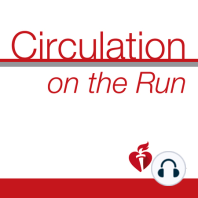16 min listen
Circulation July 30, 2019 Issue
ratings:
Length:
23 minutes
Released:
Jul 29, 2019
Format:
Podcast episode
Description
Dr Carolyn Lam: Welcome to Circulation on the Run, your weekly podcast summary and backstage pass to the Journal and its editors. We're your cohosts. I'm Dr Carolyn Lam, Associate Editor from the National Heart Center and Duke National University of Singapore. Dr Greg Hundley: I'm Greg Hundley, Associate Editor of Circulation, Director of the Pauley Heart Center at VCU Health in Richmond, Virginia. Dr Carolyn Lam: Greg, guess what? We are going to be talking later about non-inferiority trials. Now, you're going to go like, "Huh? What?," but then we see more and more non-inferiority cardiovascular trials. And do we really know the advantages and limitations of this type of trial design? Which is so important to understand, because we need to understand the factors that may impact our confidence and interpretation of these results. So, that's going to be a really important feature discussion, coming up right after our coffee chat. Greg, what are your papers? Dr Greg Hundley: Thanks Carolyn. Boy, I can't really wait to get to that feature discussion. That's something that we deal with all the time, and I look forward to that explanation and that discussion. I'm going to talk a little bit of basic science, with two papers right in a row. And the first one involves catecholaminergic polymorphic ventricular tachycardia through inhibition of calcium/calmodulin-dependent kinase II. The lead author is Dr Vassilios Bezzerides from Boston Children's Hospital. Carolyn, this paper focuses on treatment of catecholaminergic polymorphic ventricular tachycardia, an underlying diagnosis in at least 12% of pediatric patients who present with unheralded cardiac arrest. ICDs, as you know, are frequently implanted, but are problematic because of increased complication rates in pediatric patients, failure to convert ventricular arrhythmias, and the risk of fatal ICD-induced electrical storm. Modulating CaM Kinase II within the heart shows promise to treat this, but CaM Kinase II is essential in other tissues, most notably the brain. Dr Carolyn Lam: How interesting. So, what did the study show? Dr Greg Hundley: Well, the investigator used adeno-associated viral gene therapy, which is proven to be a safe and efficient vector for sustained gene transfer into many cell types to selectively inhibit CaM Kinase II in cardiomyocytes. They were able to express the specific CaM kinase II inhibitory peptide AIP in cardiomyocytes without significant extra cardiac expression, and an inhibition of CaM Kinase II effectively suppressed ventricular arrhythmias in a murine model of catecholaminergic polymorphic ventricular tachycardia after a single therapeutic dose. So thus, in animal models, delivery of a CaM Kinase inhibitory peptide by AAV represents a novel single dose gene therapy for catecholaminergic polymorphic ventricular tachycardia. How about that? Dr Carolyn Lam: Wow. You've got a second paper? Dr Greg Hundley: I sure do. So now we're going to jump into, again, looking at polymorphic VT from engineered human heart tissue. And this article is from Kevin Parker at Harvard University, "Modeling of Human Arrhythmias Using Induced Pluripotent Stem Cell-Derived Cardiomyocytes has Focused on Single-Cell Phenotypes." With this said, it is important to realize that arrhythmias are emergent properties of cells assembled into tissues and the impact of inherited Arrhythmia mutations on tissue level properties of human heart tissue. And therefore, newer technologies are needed to develop more satisfactory therapeutic interventions. Ones that encompass all of the tissue, not just single cells. Dr Carolyn Lam: Interesting. So, what did this particular study do? Dr Greg Hundley: So, Carolyn, i
Released:
Jul 29, 2019
Format:
Podcast episode
Titles in the series (100)
Circulation June 6, 2017 Issue: Circulation Weekly: Your Weekly Summary & Backstage Pass To The Journal by Circulation on the Run
